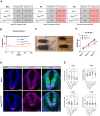This is a preprint.
Receptor Allostery Promotes Context-Dependent Sonic Hedgehog Signaling During Embryonic Development
- PMID: 39975106
- PMCID: PMC11838287
- DOI: 10.1101/2025.01.28.635336
Receptor Allostery Promotes Context-Dependent Sonic Hedgehog Signaling During Embryonic Development
Abstract
Sonic Hedgehog (SHH) signaling functions in temporal- and context-dependent manners to pattern diverse tissues during embryogenesis. The signal transducer Smoothened (SMO) is activated by sterols, oxysterols, and arachidonic acid (AA) through binding pockets in its extracellular cysteine-rich domain (CRD) and 7-transmembrane (7TM) bundle. In vitro analyses suggest SMO signaling is allosterically enhanced by combinatorial ligand binding to these pockets but in vivo evidence of SMO allostery is lacking. Herein, we map an AA binding pocket at the top of the 7TM bundle and show that its disruption attenuates SHH and sterol-stimulated SMO induction. A knockin mouse model of compromised AA binding reveals that homozygous mutant mice are cyanotic, exhibit high perinatal lethality, and show congenital heart disease. Surviving mutants demonstrate pulmonary maldevelopment and fail to thrive. Neurodevelopment is unaltered in these mice, suggesting that context-dependent allosteric regulation of SMO signaling allows for precise tuning of pathway activity during cardiopulmonary development.
Conflict of interest statement
Competing Interests The authors declare no competing interests.
Figures







References
-
- Jiang J. & Hui C. C. Hedgehog signaling in development and cancer. Dev Cell 15, 801–812 (2008). https://doi.org/S1534-5807(08)00484-X [pii] 10.1016/j.devcel.2008.11.010 - DOI - PMC - PubMed
Publication types
Grants and funding
LinkOut - more resources
Full Text Sources
Molecular Biology Databases
Miscellaneous
